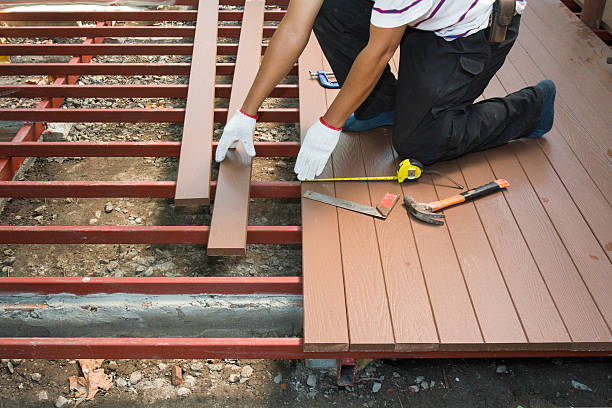
Which is the best cedar for decking?
When it comes to decking materials, two natural contenders have consistently captured the attention of homeowners and builders; redwood and cedar. These two hardwoods are known for their durability, beauty, and versatility.
As a result, they have long been celebrated for their ability to transform ordinary outdoor spaces into breathtaking extensions of our living areas. But the question remains: which of these magnificent timbers reigns supreme in the world of decking?
In this article, we will discuss the characteristics of redwood and cedar and thus shed light on the unique qualities that set them apart. By delving into their origins and distinctive features, we aim to assist you in making an informed decision for your next decking project.
Cedar: Overview
Cedarwood encompasses various species from the Cedrus and Thuja tree families. Amongst these species, the Western Red Cedar (Thuja plicata) and Eastern Red Cedar (Juniperus virginiana) are the primary choices for commercial purposes.
Cedar is popularly known for its natural beauty and distinct appeal. It is the top choice for decking and fencing enthusiasts seeking a touch of elegance and a closer connection to nature.
They are a popular option that offers a range of desirable attributes. Cedars also serve as an excellent alternative to pressure-treated wood.
One of the key factors that make cedar so coveted is its innate resistance to rotting. Their resistance to rotting makes them an ideal material for outdoor applications.
Additionally, cedar’s aesthetic allure and ease of handling contribute to its widespread popularity among homeowners and builders. Unlike redwood, which may be limited in availability, cedar is typically accessible in most areas.
Redwood vs. Cedar: Key Comparisons
Color
When it comes to color, redwood and cedar offer distinct visual differences. Redwood lives up to its name with a reddish-brown hue that gives it a striking and unique appearance. However, it’s worth noting that the outer edges of redwood, known as sapwood, showcase a yellowish tone more akin to cedar.
Cedar, on the other hand, exhibits a range of colors, varying from pale red or pink to yellow and even nearly white. While Western Red Cedar carries a reddish hue, it falls short of the intense reddish-brown found in redwood.
In some cases, both kinds of wood can weather to a silvery gray if left untreated. When they appear in this color, they both offer a natural charm that some people like.
Meanwhile, some people prefer to maintain the original appearance through regular upkeep. Ultimately, the choice of color between redwood and cedar comes down to personal preference.
Redwoods are more receptive to tinted stains, while cedar tends to cost less, and they have a lighter natural color. The cedar’s natural color makes it an appealing option for those considering staining or painting their deck.
Grain patterns
The grain patterns of redwood and cedar offer distinct characteristics that add to the overall aesthetic appeal of these woods. Cedar showcases a tight, uniform grain with evenly spaced and closely situated grains.
Redwood, on the other hand, features a slightly wider grain that is spaced further apart. This is due to its faster growth rate, with each grain line representing a year of the tree’s growth. As redwood trees grow rapidly and reach impressive heights, the growth rings are naturally spaced further apart. Redwood can contain knots or be acquired as clear lumber, depending on the chosen grade.
While redwood exhibits a wider grain, it is generally considered “open” with fewer than 8 growth lines per inch.
So when it comes to grade availability, redwood typically offers fewer knots overall compared to cedar. It is also more readily accessible in “clear” grades, indicating the absence of knots.
In terms of overall smoothness, redwood has a slight advantage over cedar. However, the choice between the two ultimately depends on the desired look and specific project requirements.
Durability
When it comes to durability, we have a tangible difference that can be measured. The Janka hardness test allows us to gauge the hardness of redwood and cedar.
Redwood boasts a Janka rating of 450 lbs, making it approximately 23% stronger than cedar, which has a Janka rating of 350 lbs.
While the necessity of this extra strength depends on your specific project requirements, it is evident that redwood generally offers greater durability and stability than cedar.
So, whether you prioritize enhanced resilience or have specific demands for a long-lasting wood, redwood stands out as the more robust choice in this regard.
Cost Comparison
Regarding cost, cedar takes the lead as the more budget-friendly option. Not only is cedar generally less expensive than redwood, but it also offers the flexibility of purchasing planks in varying thicknesses.
However, it’s important to note that while cedar is more affordable, redwood surpasses its sturdiness and durability. Redwood’s hardness and increased durability justify its higher price tag, especially if you anticipate heavy usage of your project.
Additionally, proper maintenance can extend the lifespan of redwood, making it a more cost-effective choice in the long run due to lower maintenance costs.
While redwood tends to be slightly pricier than cedar, the price difference is insignificant enough to dismiss it as an option. Ultimately, the decision depends on the specific aesthetic preferences you have in mind.
When making choices for your siding and decking, it’s essential to consider various factors. You may also seek professional advice from Longhouse Cedar.
Conclusion
When deciding, it’s crucial to consider factors such as color preference, desired grain patterns, budget considerations, etc. If you’re looking for high-quality cedar products and professional advice, Longhouse Cedar is your go-to destination.
Contact us today and discover the exceptional cedar offerings that will enhance the beauty and durability of your outdoor spaces.
